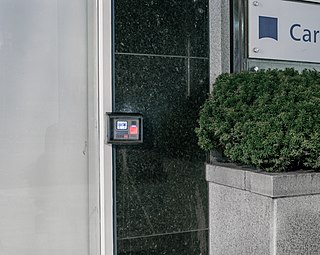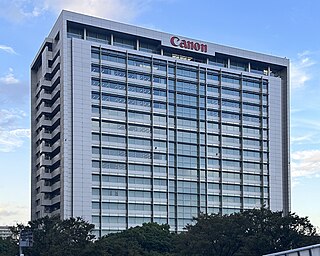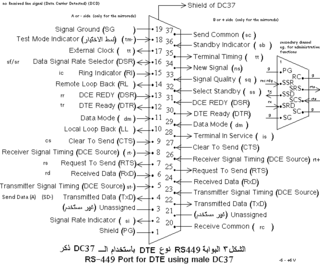
In telecommunications, RS-232 or Recommended Standard 232 is a standard originally introduced in 1960 for serial communication transmission of data. It formally defines signals connecting between a DTE such as a computer terminal, and a DCE, such as a modem. The standard defines the electrical characteristics and timing of signals, the meaning of signals, and the physical size and pinout of connectors. The current version of the standard is TIA-232-F Interface Between Data Terminal Equipment and Data Circuit-Terminating Equipment Employing Serial Binary Data Interchange, issued in 1997. The RS-232 standard had been commonly used in computer serial ports and is still widely used in industrial communication devices.

In physical security and information security, access control (AC) is the selective restriction of access to a place or other resource, while access management describes the process. The act of accessing may mean consuming, entering, or using. Permission to access a resource is called authorization.

MIL-STD-188 is a series of U.S. military standards relating to telecommunications.

The Telecommunications Act of 1996 is a United States federal law enacted by the 104th United States Congress on January 3, 1996, and signed into law on February 8, 1996, by President Bill Clinton. It primarily amended Chapter 5 of Title 47 of the United States Code.

Canon Inc. is a Japanese multinational corporation headquartered in Ōta, Tokyo, specializing in optical, imaging, and industrial products, such as lenses, cameras, medical equipment, scanners, printers, and semiconductor manufacturing equipment.

RS-422, also known as TIA/EIA-422, is a technical standard originated by the Electronic Industries Alliance, first issued in 1975, that specifies electrical characteristics of a digital signaling circuit. It was meant to be the foundation of a suite of standards that would replace the older RS-232C standard with standards that offered much higher speed, better immunity from noise, and longer cable lengths. RS-422 systems can transmit data at rates as high as 10 Mbit/s, or may be sent on cables as long as 1,200 meters (3,900 ft) at lower rates. It is closely related to RS-423, which uses the same signaling systems but on a different wiring arrangement.

Secure Terminal Equipment (STE) is the U.S. government's current, encrypted telephone communications system for wired or "landline" communications. STE is designed to use ISDN telephone lines which offer higher speeds of up to 128 kbit/s and are all digital. The greater bandwidth allows higher quality voice and can also be utilized for data and fax transmission through a built-in RS-232 port. STE is intended to replace the older STU-III office system and the KY-68 tactical system. STE sets are backwards compatible with STU-III phones, but not with KY-68 sets.
Cable One, Inc. is an American broadband communications provider. Under the Sparklight brand, it provides service to 24 states and 1.1 million residential and business customers. It is headquartered in Phoenix, Arizona, though it does not serve that metro area.

The Squad Advanced Marksman Rifle (SAM-R) is a semi-automatic designated marksman rifle developed and used by the United States Marine Corps. It gave users the capability to provide fire in support of a rifle squad, providing precision fire in support of an assault, and aid in observation and adjusting of supporting arms.

Automatic test equipment or automated test equipment (ATE) is any apparatus that performs tests on a device, known as the device under test (DUT), equipment under test (EUT) or unit under test (UUT), using automation to quickly perform measurements and evaluate the test results. An ATE can be a simple computer-controlled digital multimeter, or a complicated system containing dozens of complex test instruments capable of automatically testing and diagnosing faults in sophisticated electronic packaged parts or on wafer testing, including system on chips and integrated circuits.

The RS-449 specification, also known as EIA-449 or TIA-449, defines the functional and mechanical characteristics of the interface between data terminal equipment, typically a computer, and data communications equipment, typically a modem or terminal server. The full title of the standard is EIA-449 General Purpose 37-Position and 9-Position Interface for Data Terminal Equipment and Data Circuit-Terminating Equipment Employing Serial Binary Data Interchange.
SEMI is an industry association comprising companies involved in the electronics design and manufacturing supply chain. They provide equipment, materials and services for the manufacture of semiconductors, photovoltaic panels, LED and flat panel displays, micro-electromechanical systems (MEMS), printed and flexible electronics, and related micro and nano-technologies.

The Cable Communications Policy Act of 1984 was an act of Congress passed on October 30, 1984 to promote competition and deregulate the cable television industry. The act established a national policy for the regulation of cable television communications by federal, state, and local authorities. Conservative Senator Barry Goldwater of Arizona wrote and supported the act, which amended the Communications Act of 1934 with the insertion of "Title VI—Cable Communications". After more than three years of debate, six provisions were enacted to represent the intricate compromise between cable operators and municipalities.

Panasonic Avionics Corporation (PAC) designs, engineers, manufactures, sells and installs customized in-flight entertainment and communications devices to airlines worldwide. It is a subsidiary of Panasonic Corporation of North America, the principal North American subsidiary of Panasonic Corporation. Panasonic Avionics Corporation was founded in 1979 as Matsushita Avionics Systems Corporation and changed its name in 2005. It is headquartered in Irvine, California and has major business functions in Bothell, WA.

The Intersputnik International Organization of Space Communications, commonly known as Intersputnik, is an international satellite communications services organization founded on 15 November 1971, in Moscow by the Soviet Union along with a group of eight formerly socialist states.
The SECS/GEM is the semiconductor's equipment interface protocol for equipment-to-host data communications. In an automated fab, the interface can start and stop equipment processing, collect measurement data, change variables and select recipes for products. The SECS /GEM standards do all this in a defined way.
The SECS-II, sometimes called SEMI E5, is a communication protocol used in the semiconductor industry between devices involved in manufacturing. Much like the protocols in the OSI model, SECS-II is a layer above SECS-I and HSMS. While SECS-I and HSMS define how the communications are transmitted, SECS-II defines the format and content of messages that can be sent over SECS-I or HSMS.

Fort Lee Air Force Station is a former United States Air Force station. It is located 2.9 miles (4.7 km) northwest of Prince George, Virginia. It was closed in 1983 due to budget cuts.
The High-Speed SECS Message Services (HSMS) protocol is a standard transport protocol for communication between production equipment and factory control systems in semiconductor factories. HSMS defines a TCP/IP based Ethernet connection and is intended as a high speed alternative to the serial SECS-I protocol. HSMS is defined in the SEMI standard E37.












